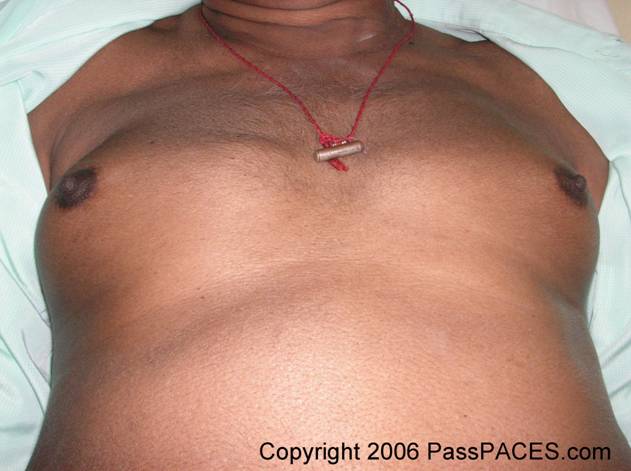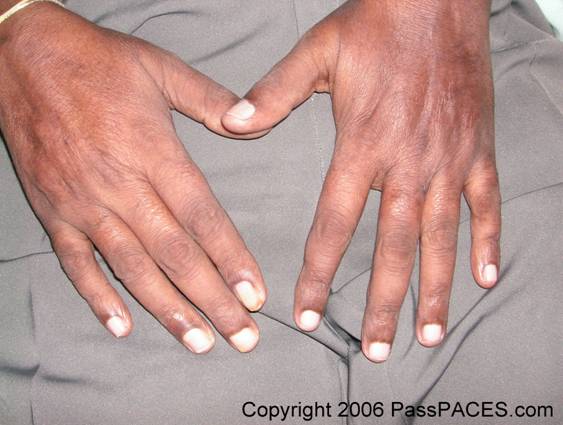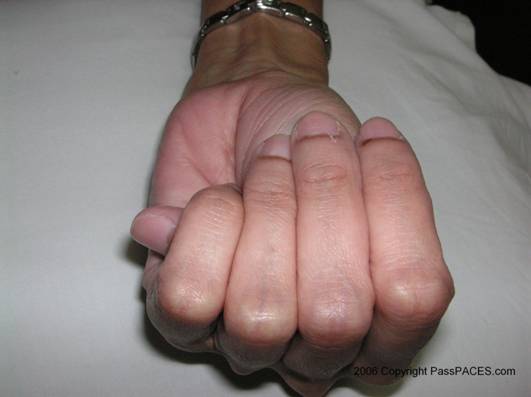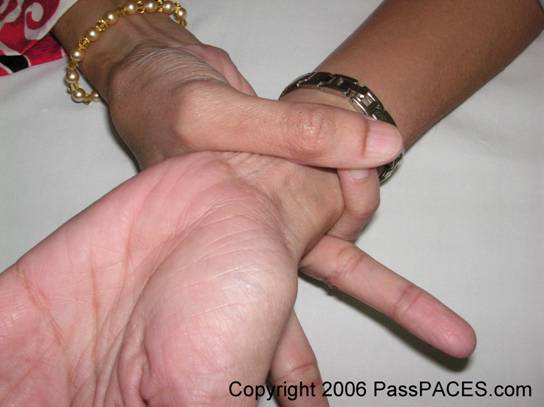
|
|
|||||
|
|
|
|
|
|
|
![]()
YOUR LATEST ISSUE ABOUT MRCP PACES IS HERE!
Examine this gentleman's abdomen.

Discussion:
As I mentioned in my previous posts. You should score in your abdominal station. This is because there are only very limited possibilities in abdominal station. You notice this gentleman has gynaecomastia as evidenced by presence of breast tissue.Look for other stigmata of chronic liver disease such as clubbing, Dupuytren's contracture,palmar erythema, spider naevi, flapping tremor, leukoonychia,scratch mark,jaundice,pallor, pigmentation,cyanosis,xanthomata,purpura,koilonychia,paronychia, oedema, muscle wastimg, tattoos, needle marks....( you would be surprised to find that there are so many physical signs in chronic liver disease!).Although there are a lot of causes for gynaecomastia, if you find this in your abdominal station, always think of chronic liver disease. Remember that common drugs that are associated with gynaecomastia are ketoconazole, spirolactone, H2 antagonist such as cimetidine and psychoactive drugs.If you look at the periphery, you would find the following,

Yes, you would notice that this gentleman also has leukonychia. Anticipate to find hepatosplenomegaly in this gentleman. Demonstarte to examiners that you know how to check for ascites by showing shifting dullness. Showmanship is important in MRCP clinical exam. Always examine your patient systematically and confidently.
Common questions examiners would ask you,
2) What are the common trigerring factors for hepatic encephalopathy?
3) How do you diagnose spontaneous bacterial peritonitis?
4) What is your long term plan for liver cirrhosis patients?
Conclusion:
This patient has chronic liver cirrhosis due to alcoholism.
Extra points:
2) Learn more about CAGE questions when you want to get further alcohol history from a patient! ( Study back your medical school book to learn more!)
| Case ID: 2 | Created: 5 August 2006 |
Examine this lady's hands


Discussion:
This is the continuation discussion from the previous issue. As I mentiond in previous article, Marfan Syndrome is a popular cardiology case in MRCP. However, this case can come out in Station 5 as well. You notice that this lady fingers are long. I would like to show the thumb and wrist signs as I mentioned in previous issue. Always remember that for you to diagnose Marfan syndrome, you need to know about the major criteria. Major criteria for Marfan syndrome include Ectopia Lentis ( upward dislocation of the len), dilatation of aortic root or aortic dissection and lumbarsacral dural ectasia ( you only can diagnose this by MRI or CT scan). If patient has family history , you need two systems involvement ( either skeletal system, ocular, cardiovascular or other system ) to diagnose Marfan syndrome. If patient does not has family history,then you need two systems involvement plus one major criteria!
Common questions examiners would ask you,
1) How do you manage this condition? ( Remember about genetic counselling and patient's education)
2) What are common cardiovascular lesions in Marfan syndrome?
Conclusion:
This lady has Marfan syndrome
Extra points,
1) To look at other photos about Marfan syndrome, click www.passpaces.com/MRCP/issue14.html
2) Remember the complications of Marfan syndrome!
To see previous issues, click here! To send a quick comment, click here!